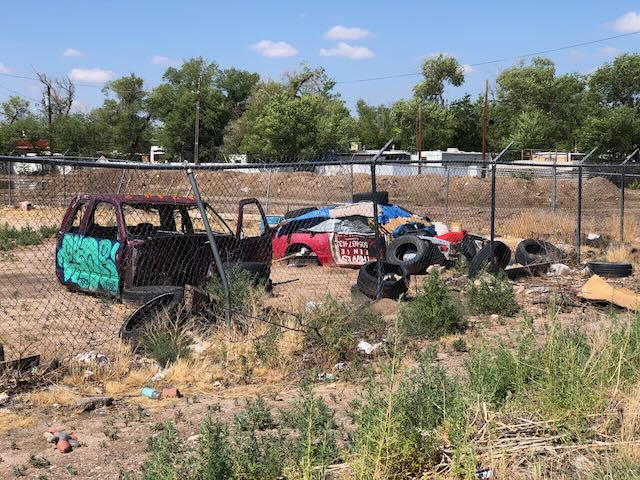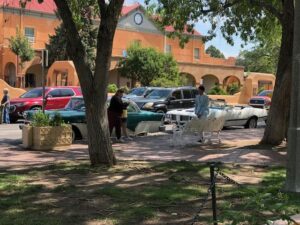Soto Avenue in Albuquerque’s Old Town Neighborhood is more “alley” than “avenue”. It’s one of our bicycling work-arounds for the unrideable stretch of Central Avenue – old Route 66 – on the east side of the Rio Grande in Albuquerque.
I ducked down Soto this morning at the tail end of a wandery bike ride. I love it because, like all alleys, it has a respectable honesty. Just look at those two cars, out beyond an abandoned car repair shop – the entropy that has long since settled over the place. Nobody’s puttin’ on airs here.
Two blocks to the east, I settled on a shady bench in Albuquerque’s Old Town to finish the El Modelo breakfast burrito I’d stashed in my jersey pocket for bike ride food. It’s a Sunday thing. I often triangulate my ride on Old Town as I’m heading home, stopping to enjoy the theater of humanity – the tourists, the working church, the shade, and the informal car show. They’re out there, every Sunday, arriving early enough to lock down the prized parking places along the north side of the plaza.
The compare and contrast between Soto’s back lot junk and Old Town’s gleaming works of automotive art was striking. I’m pushing the boundaries of the metaphors of theoretical physics when I draw on the idea of entropy here, but if we’re careful about those boundaries, it works.
Left in the elements, with no one investing energy in their maintenance and repair, the old junkers are tending toward disorder. That’s increasing entropy. Enormous amounts of love and energy have been invested in the Old Town masterpieces. They are tending toward order. That’s decreasing entropy.
I’m at the edge of breaking this metaphor, but it slots nicely into Candide’s tending of the garden. Absent tending, gardens, like old cars in a back lot, tend toward disorder. Here’s Stanley Crawford talking in his book Village. He’s talking about “the idea of the perfect front yard, the perfect courtyard, the ideal patio, even the perfect vegetable garden“:
Once achieved, what inevitably followed was degradation, decay, the maddening weeds of imperfection, the cracks in the expensive paving, trees that grew too tall and trees that refused to grow fast enough, trees that failed to blossom at the right time, trees that gave fruit that wasn’t quite what was wanted or that came all at once, too much to deal with.



Somewhere I had a geochemistry book on entropy left over from grad school. I wish it had explained entropy as well as you just did.
The idea that a living system is disordered is of course incomplete. Cycles within cycles as the millions of species try to complete their own individual missions through life – some compete, some cooperate and others are just their doing their own thing no matter what everyone else thinks and as you cycle your own cycle (metaphorically and also literally 🙂 )…
perhaps chaos
is just what
nature ordered
Random events in nature. Hurricane Beryl now attacking the Windward Islands.
The last time I was in Albuquerque, I went out West of the Rio Grande to see if dad’s old gas station/repair shop was still standing. Just an empty lot where 10 years before a very old building once stood. Times change.